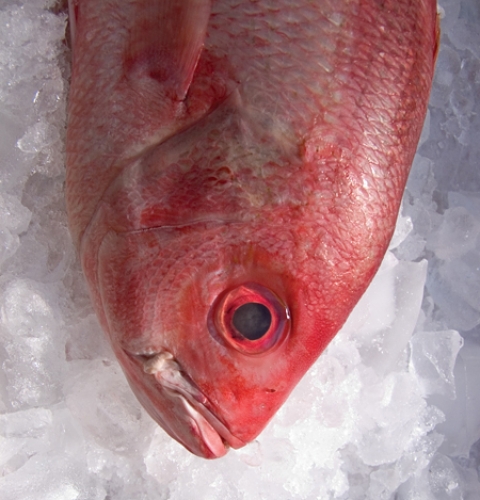Peter Marko, assistant professor of marine sciences, had heard this tale many times: the red snapper we so often eat — one of the more popular and expensive fish on the market — isn’t really red snapper.
So to test the anecdotes and to give a graduate class in molecular biology a chance at some hands-on learning, Marko designed a simple class project: conduct a molecular genetic analysis of twenty-two red snapper bought from nine vendors across eight states.
The results?
Seventeen of the twenty-two fish, or 77 percent, weren’t red snapper after all. The margin of error of 17 percent in this study, Marko says, means that between 60 and 94 percent of the red snapper bought in the United States are some other species.
The findings, Marko says, represent a larger problem facing the seafood industry: seafood substitution — the selling of a cheaper seafood under the name of a more expensive one.
“Though we confirmed there’s some fish fraud going on,” says Amy Moran, research assistant professor of marine sciences and coauthor of the study, “the big unanswered questions remain.”
Like, why are fish mislabeled? And at what stage in the commercial process — when fish go from the sea to the dinner plate — does the mislabeling occur?
Some of the answers to these questions lie in the fish that were substituted for the red snapper that Marko’s class bought.
Five of the fish were other snappers (lane and vermilion snapper) that are also fished in the Western Atlantic where red snapper is fished. But nearly half of the fish could not be identified at all because those species have no sequences recorded in GenBank, a database maintained by the National Institutes of Health that stores the molecular genetic sequences of all snapper managed by the National Marine Fisheries Service.
“Therefore, these fish are either relatively uncommon Atlantic species or they’re from other ocean basins,” Marko says.
At least two fish from the sample were crimson snapper, which are native to the tropical west Pacific and the eastern Indian oceans.
This discovery indicates some mislabeling may occur when the fish are being processed for public consumption, Marko says. Other mislabeling might also occur on the docks and boats.
“Mislabeling not only defrauds consumers,” Moran says, “it potentially affects wildlife management if mislabeling occurs before catch data are collected by management agencies.”
Regardless of where it occurs in the industry, Marko adds, it greatly distorts the public perception of the true abundance of some species. “Many commercial fish species are heavily depleted,” he says, because they’re overfished and inadvertently caught as bycatch of other fisheries.
In 1996, the Gulf of Mexico Fishery Management Council imposed tighter restrictions on red snapper due to overfishing and bycatch of juvenile red snapper in shrimp trawls. But “tight restrictions may create an economic incentive for seafood substitution, whereby less valuable species are mislabeled and sold under the names of more expensive ones,” the authors write in the July 15, 2004, issue of Nature.
Red snapper, for example, costs the consumer about twelve dollars a pound. Rockfish, often substituted for red snapper, runs about two dollars a pound. Several years ago the Food and Drug Administration (FDA) intercepted a batch of about a thousand pounds of rockfish labeled as red snapper headed for public purchase. The company would have netted an excess profit of more then twelve thousand dollars.
To help combat such fish fraud, the FDA requires that fish be labeled accurately. The FDA also requires, as of September 2004, that retail outlets label fish by country of origin. The country of origin for red snapper should be the United States.
What other steps should consumers take to make sure they get the fish they want?
“Since it’s not realistic for most consumers to be able to identify fish by just looking at them,” Marko says, “the best thing to do is to avoid buying species whose stocks are overfished.
“Species that are not overfished tend not to be substituted by other fish. There’s less economic incentive to do so,” he adds. “If you do buy a fish that’s overfished, there’s some chance that you’re not going to get what you’re paying for.”
Cherry Crayton was formerly a staff writer for Endeavors.
Want to make sure you’re making environmentally sound seafood choices and getting your money’s worth? The Monterey Bay Aquarium released a Seafood Watch guide for the southeastern United States last spring that lists the best fish to buy and to avoid.


